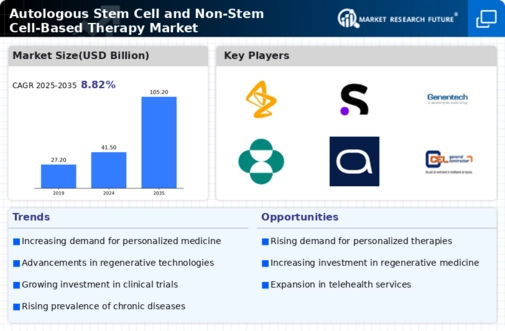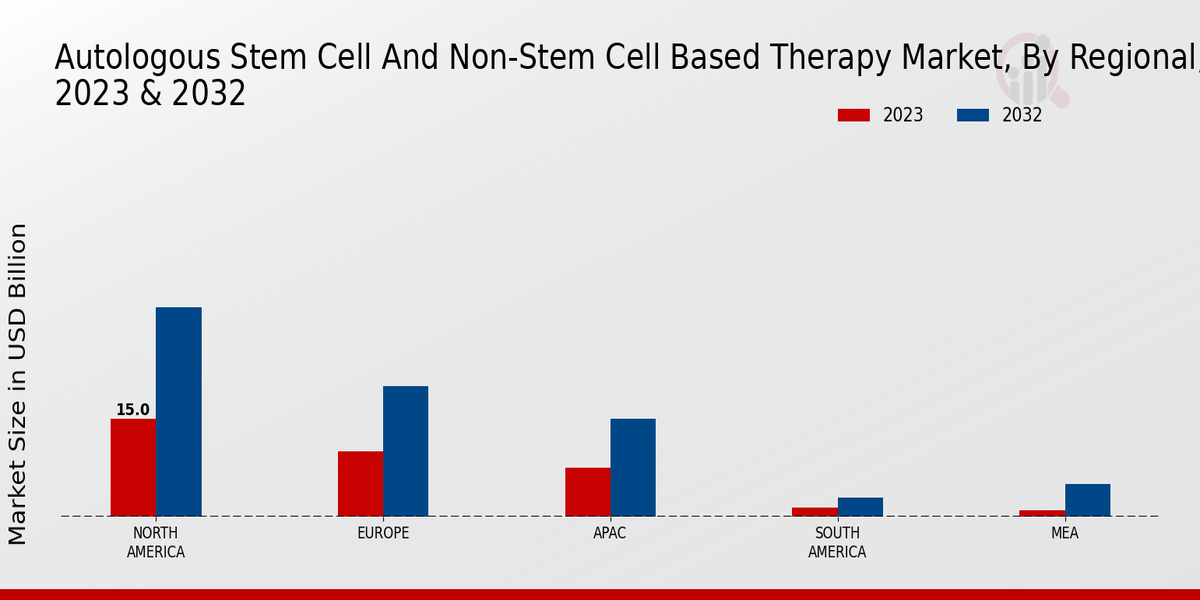Market Growth Projections
The Global Autologous Stem Cell and Non-Stem Cell-Based Therapy Market Industry is poised for remarkable growth, with projections indicating a market size of 41.5 USD Billion in 2024 and an anticipated increase to 105.2 USD Billion by 2035. This growth trajectory suggests a compound annual growth rate of 8.82% from 2025 to 2035, reflecting the increasing adoption of innovative therapies. The expansion is driven by various factors, including technological advancements, rising chronic disease prevalence, and supportive regulatory frameworks. As the market evolves, it is expected to attract significant investments and foster collaborations, further enhancing the development and accessibility of autologous and non-stem cell-based therapies.
Supportive Regulatory Frameworks
Supportive regulatory frameworks are pivotal in fostering the growth of the Global Autologous Stem Cell and Non-Stem Cell-Based Therapy Market Industry. Governments and regulatory bodies are increasingly recognizing the potential of cell-based therapies, leading to streamlined approval processes and incentives for research and development. Initiatives aimed at promoting innovation and ensuring patient safety are likely to enhance market accessibility. As regulations evolve to accommodate new technologies and methodologies, the market is expected to expand, attracting investments and encouraging collaboration among stakeholders. This supportive environment is essential for the continued advancement of therapies and the overall growth of the market.
Rising Demand for Personalized Medicine
The Global Autologous Stem Cell and Non-Stem Cell-Based Therapy Market Industry experiences a notable increase in demand for personalized medicine. This trend is driven by advancements in genomics and biotechnology, allowing for tailored treatments that cater to individual patient needs. As patients seek therapies that are specifically designed for their unique genetic profiles, the market is projected to reach 41.5 USD Billion in 2024. The shift towards personalized approaches not only enhances treatment efficacy but also minimizes adverse effects, thereby fostering patient satisfaction and adherence. This growing inclination towards customized therapies is likely to propel the market further, indicating a robust growth trajectory.
Increasing Prevalence of Chronic Diseases
The Global Autologous Stem Cell and Non-Stem Cell-Based Therapy Market Industry is significantly influenced by the rising prevalence of chronic diseases such as diabetes, cardiovascular disorders, and neurodegenerative conditions. These diseases often require long-term management and innovative treatment solutions, which autologous and non-stem cell therapies can provide. As healthcare systems worldwide grapple with the burden of chronic illnesses, the demand for effective therapies is expected to surge. This trend is likely to contribute to the market's growth, with projections indicating a potential market size of 105.2 USD Billion by 2035. The increasing focus on addressing chronic health issues underscores the importance of these therapeutic modalities.
Technological Advancements in Cell Therapy
Technological innovations play a crucial role in shaping the Global Autologous Stem Cell and Non-Stem Cell-Based Therapy Market Industry. Cutting-edge techniques such as CRISPR gene editing and advanced cell culture systems are enhancing the efficiency and effectiveness of therapies. These advancements facilitate the production of high-quality stem cells and improve the precision of non-stem cell-based treatments. As a result, the market is anticipated to witness a compound annual growth rate of 8.82% from 2025 to 2035. The integration of technology not only streamlines production processes but also expands the range of treatable conditions, thereby broadening the market's scope and appeal.
Growing Investment in Regenerative Medicine
Investment in regenerative medicine is a driving force behind the Global Autologous Stem Cell and Non-Stem Cell-Based Therapy Market Industry. As stakeholders recognize the transformative potential of regenerative therapies, funding from both public and private sectors is increasing. This influx of capital supports research initiatives, clinical trials, and the commercialization of innovative therapies. The growing interest in regenerative medicine is likely to accelerate the development of new treatment options, further expanding the market. With the anticipated growth trajectory, the market is positioned for substantial advancements, reflecting the commitment of the healthcare community to explore and harness the benefits of regenerative approaches.

























Leave a Comment